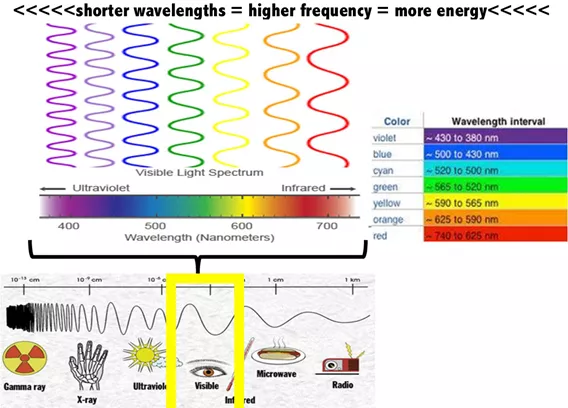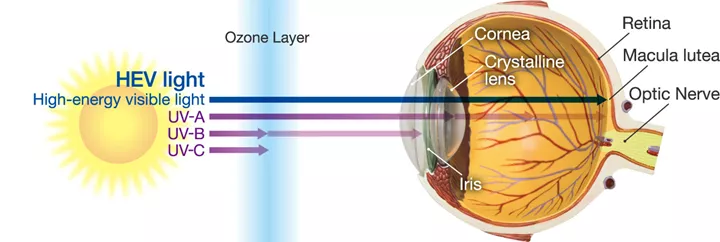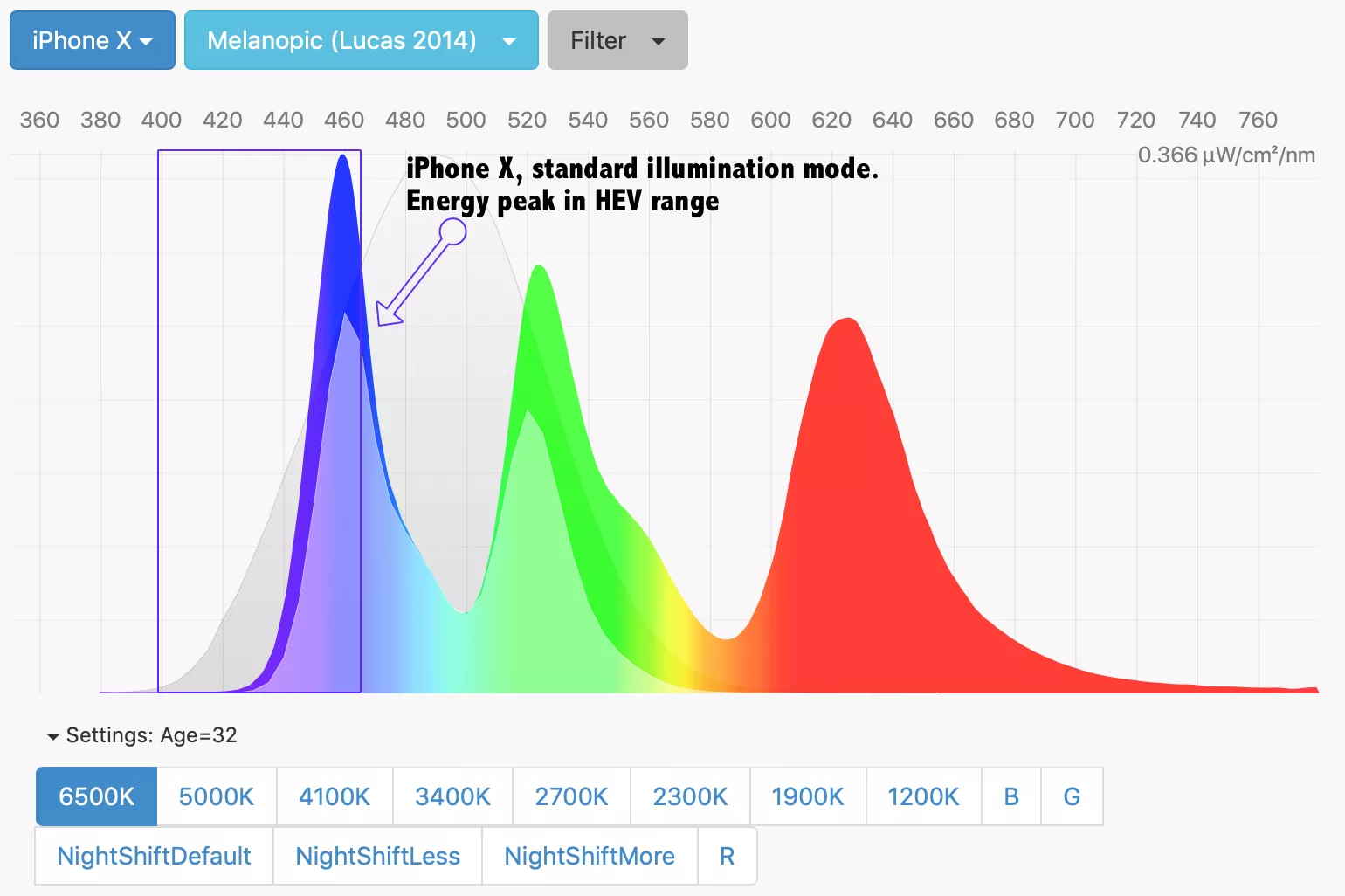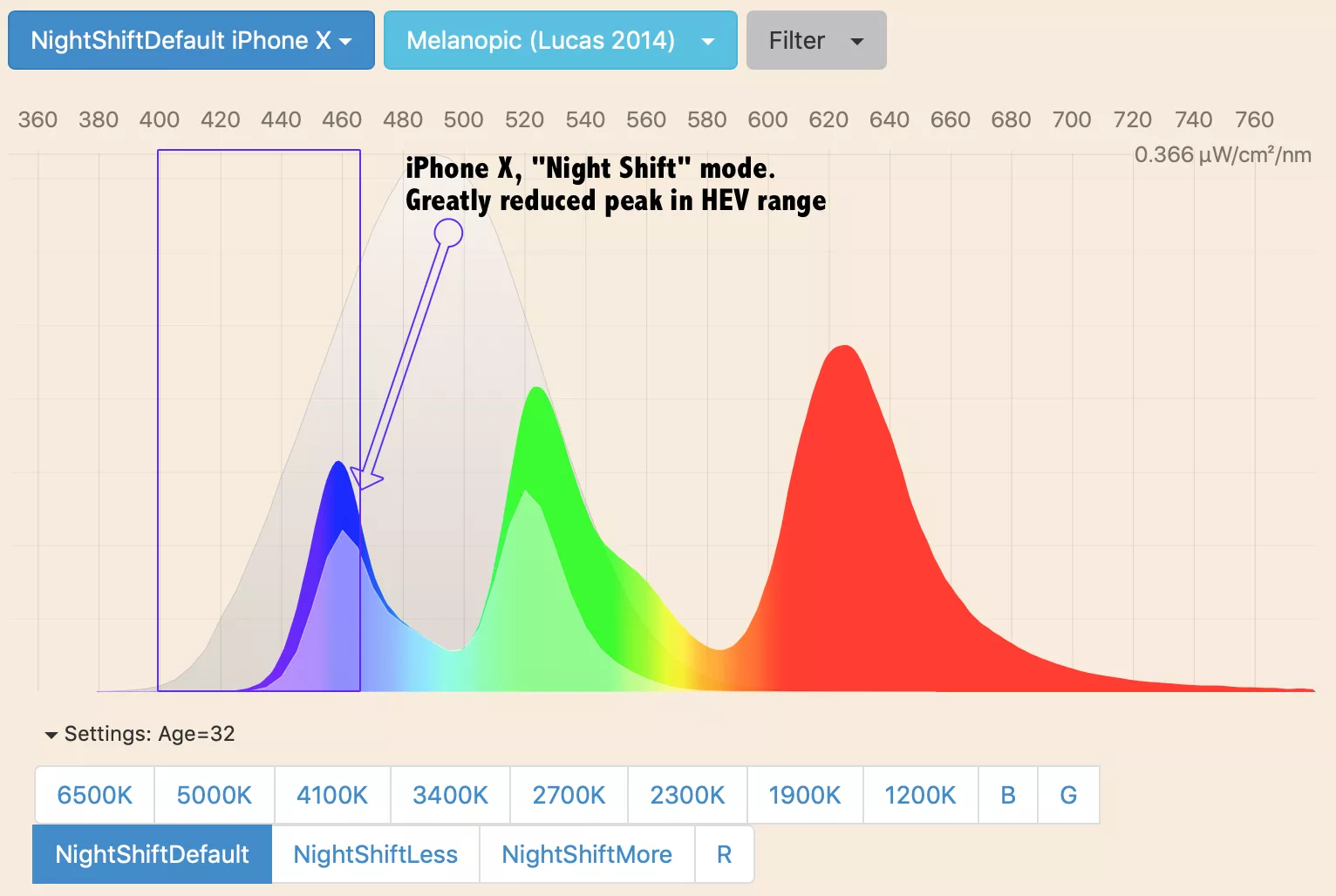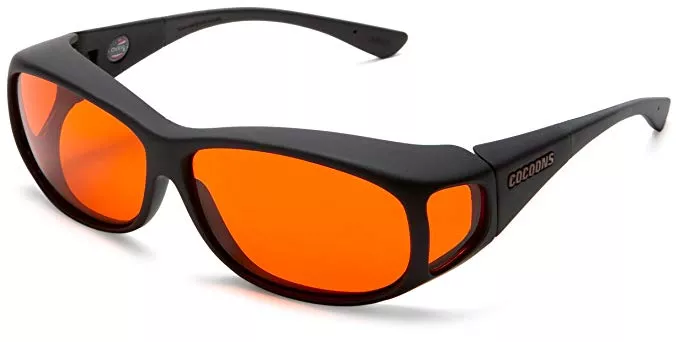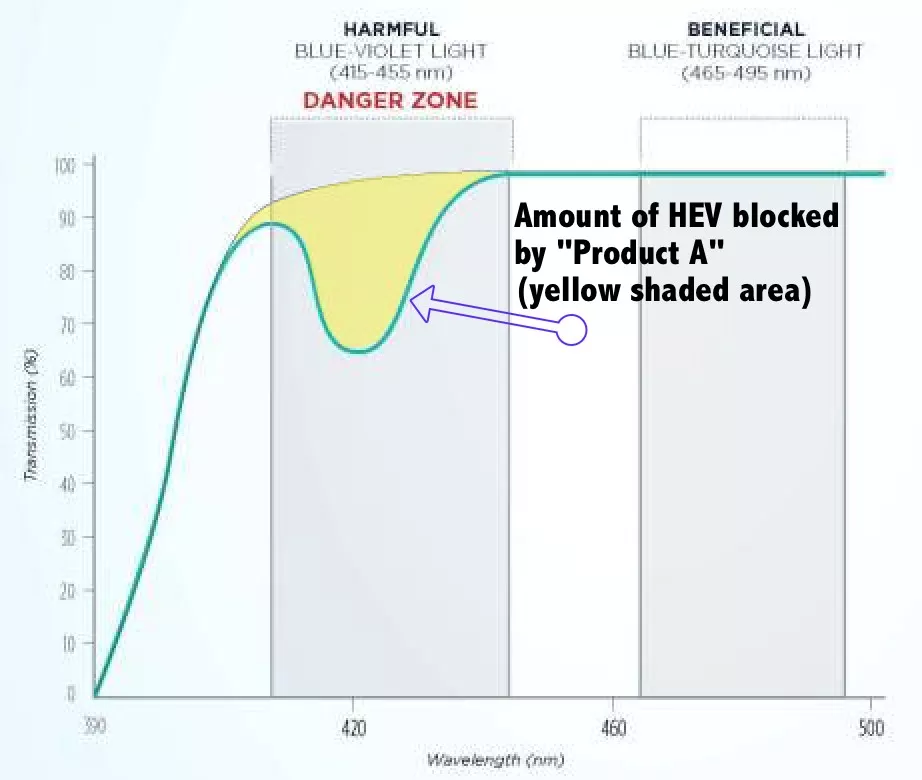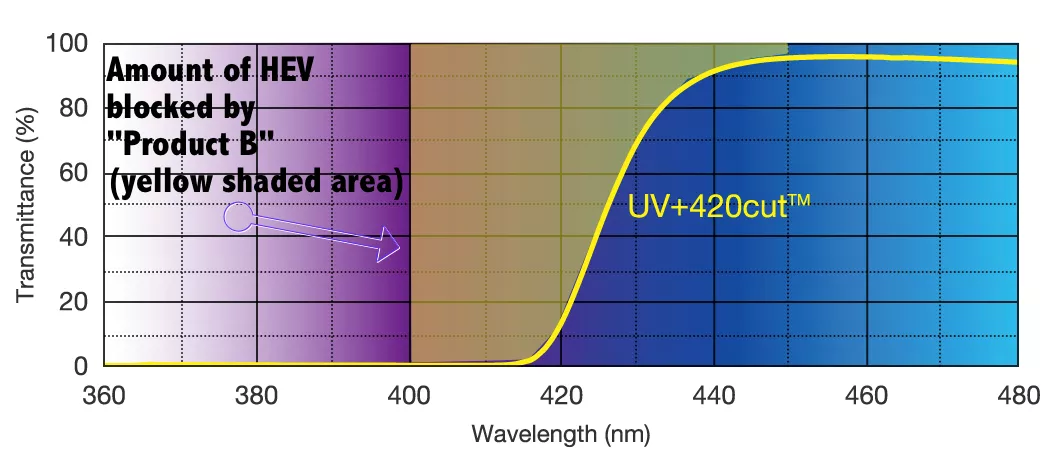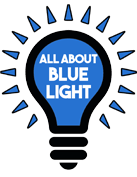All About Blue Light, 2024 Edition
Blue Light glasses are a big topic these days, so based on thousands of customer interactions and questions, we have tried to answer the most pressing Blue Light concerns right here, in one place. Here are the main Q&A topics we have received about Blue Light, and why they’re important to understand.
Are My Eyes in Danger from Blue Light?
What About Blue Light and Digital Eye Strain?
What about Blue Light and Sleep?
I Wear Prescription Glasses, How Do I Protect My Eyes from Blue Light?
TLDNR. Tell me about Blue Light Protection in one paragraph.
References, Technical Articles, and Links about Blue Light.
What is Blue Light?
The visible light spectrum taught in school uses the acronym ROY-G-BIV (Red, Orange, Yellow, Green, Blue, Indigo, Violet). When we see all of those colors combined, it appears as white light (think sunlight). As we examine individual colors of the visible spectrum and move from the Red towards the Violet end of the spectrum (right to left on Fig. A), the wavelengths become shorter. Since light travels at a constant speed, a shorter wavelength means we receive the shorter Violet waves at a higher frequency – and therefore, those wavelengths contain more energy. Light waves are measured in nanometers (nm = billionths of a meter), so for the discussion of Blue Light, we are currently looking at the part of the spectrum from 400nm to 500nm. In scientific research, this part of the visible spectrum is called Short Wavelength Light – so many names, I know!
If we keep moving past the Violet portion of the visible spectrum towards even shorter waves, we get into the Ultraviolet range (UV). This part of the spectrum is invisible to the human eye, and contains even smaller waves, higher frequencies, and more energy than visible light. We know from many years of evidence that UV light can cause skin damage, damage to the frontal structures of the eye (cornea and crystalline lens), and damage DNA structures leading to some cancers. Fortunately, the public is relatively well informed about the effects of too much UV exposure, so they use sunscreen to protect their skin and UV-blocking sunglasses for their eyes. Most of the small wavelengths of UV light are absorbed by the front structures of the eye (cornea and crystalline lens), and the majority do not pass through to the retina. That is one main difference you need to be aware of between UV light and Blue Light – UV generally gets absorbed by the front of the eye, while Blue Light passes through to reach the sensitive tissues in the back of the eye, such as the retina.
Figure A
BIG IDEA 1 – The number one way to protect your eyes from most known damages (Ultraviolet and Blue Light included) is to wear quality UV blocking sunglasses when you are exposed to bright sunlight! If you do nothing else, please invest in good sunglasses and wear them when outdoors!
We can further divide Blue Light into two main categories (Fig B):
1. Blue-Violet (roughly 400nm to 450nm), also known as HEV = High Energy Violet, or Harmful Blue Light. This portion of the spectrum is known to pass through the cornea and lens of the eye and can reach the retina. In laboratory settings on animal subjects and tissues, Blue-Violet light has been shown to cause cumulative and lasting damage to retinal structures, leading to vision loss. In particular, the Blue Violet light causes oxidative stress that leads to the destruction of photoreceptor cells – the actual cells that process light and help create vision. Most of the Blue Light research has used varying Blue-Violet wavelengths between the range of 405nm to 455nm. For optical purposes, we will generalize this potentially harmful category as Blue-Violet light from 400-450nm.
2. Blue-Turquoise (roughly 450 to 500nm) sometimes known as Good Blue Light (we’ll discuss issues with this in a later section on sleep). This portion of the spectrum also passes through the front surfaces of the eye to reach the retina. Light in this range has been shown to reduce the levels of Melatonin (our body’s natural sleep-inducing chemical) and therefore, will make humans feel more awake. In other words, Blue Turquoise light can have a strong effect on our sleep-wake cycle (aka circadian rhythms). Human exposure to Blue Turquoise Research has primarily focused on wavelengths from 460 to 480nm +/- 50nm.
Figure B
BIG IDEA 2 – Remember that regular sunlight, or white light in general, is made up of all the colors put together. Blue Light is rarely experienced in an isolated fashion. Most harmful exposure from Blue Light is actually from exposure to bright light in general – so bright light is what has the most potential to harm your eyes. For the second time – wear sunglasses outdoors to protect your eyes!
Are My Eyes in Danger from Blue Light?
As of the beginning of 2020, we can make a few statements about the potential for Blue Light damage:
1. There are studies that link long term sunlight exposure to human retinal damage, including AMD.
2. According to the American Optometric Association, most UV light is blocked by the front structures of the eye, but Blue Light passes through to reach the retina (Figure C).
3. There are studies that show, under high-exposure laboratory conditions on animal tissue samples, Blue-Violet light can cause significant and irreversible damage to retinal tissues. There is a chemical oxidation process that occurs when the blue light reacts with specific tissues and compounds in the retina. Under these intensified laboratory conditions, this type of exposure can destroy healthy tissues and could lead to AMD (Age-Related Macular Degeneration), which is currently irreversible.
4. We know that exposure to direct sunlight (which contains lots of Blue Light energy) increases risk for this cycle of retinal damage, but we don’t have enough evidence yet on digital lighting sources. However, the French governmental body in charge of health and safety (ANSES) felt strongly enough about the current evidence to issue a formal warning of the prolonged exposure to direct lighting from moderate or higher-intensity LED lighting. The concern arises from people spending more and more time on digital devices and under artificial lighting sources. Those devices generally emit Blue-Violet peaks (in the 430-460nm range), and we don’t know how much exposure causes irreversible damage yet. Questions for further study include: is it the intensity of the light, the long-term exposure, or some combination? We just don’t have 100% causal evidence yet, so professionals are urging caution and reasonable preventive measures.
*** For current technical papers and scientific explanations of exactly how Blue light affects retinal tissues, see the Technical Articles section at the end of this article.***
Figure C
BIG IDEA 3 – We know that intense Blue Light can damage retinal tissues, but we don’t know if standard digital devices and modern lighting sources are intense enough to cause significant lasting damage. The choice to purchase a blue-blocking lens is a proactive decision to ensure you are protecting your eyes – because they are the only eyes you’ve got! Remember that the sun can emit enough light to damage your eyes – now I’ve said it three times, protect your eyes from bright sunlight!
What About Blue Light and Digital Eye Strain?
Digital Eye Strain, also known as Computer Vision Syndrome (CVS) is described by the American Optometric Association as follows:
“Computer Vision Syndrome, also referred to as Digital Eye Strain, describes a group of eye and vision-related problems that result from prolonged computer, tablet, e-reader and cell phone use. Many individuals experience eye discomfort and vision problems when viewing digital screens for extended periods. The level of discomfort appears to increase with the amount of digital screen use.”
In general terms, digital eye strain is a group of symptoms, but the type of light involved is one of the primary causes. Many (if not most) of the current digital screens on the market (laptops, phones, tablets) generate a peak light transmission in the HEV range. Look at Figure D for a spectrographic analysis of the light emitted from an Apple iPhone X screen. You will notice that the peak light frequency is emitted in the 460nm range. This is a common characteristic of current LED screens. If you are interested in searching a database of dozens of currently used devices to get an idea of the frequencies they transmit, check out the following link: https://fluxometer.com/rainbow/
Figure D
We have already discussed that HEV in the 400-460nm range could be potentially harmful, but it also creates some difficulties for human vision. These wavelengths of blue light are hard for the human eye to focus on because they tend to get slightly scattered by the eye, and the blue light also tends to be focused in front of the retina, making it appear slightly out of focus. For some people this characteristic of Blue Light can help contribute to Digital Eye Strain.
Our digital friend – the Night Shift function. Fortunately, many digital devices now allow the operating software to change the lighting characteristics by reducing the blue frequencies. In the world of digital devices, this is generally referred to as a “Night Shift” function. Activating the Night Shift will reduce the blue content, therefore skewing the light towards the orange or red end of the spectrum. Below in Figure E is the same Apple iPhone X (from Figure D) transmission graph with the standard night shift activated. Notice how the blue light in the 460nm range is greatly reduced. When users activate the night shift function, they will notice the change in color values skewed towards an orange color, but generally adjust to the orange tinted screen without much difficulty. Using the Night Shift function can help the eyes to relax, and can also have an effect on sleep patterns (which we will discuss in the next section).
Figure E
Many of the products on the market that are sold as “gaming glasses” or yellow-orange tinted “computer glasses” are performing a similar function to a Night Shift. By using the complementary lens color of yellow or orange, they are absorbing the violet or blue range in the lens material, so it doesn’t reach your eye. In effect, that’s how light is “filtered” using colored lenses.
For people suffering from Digital Eye Strain, the amount of filtering or specific color of a filter that would be helpful can be a bit subjective and often takes some testing. There are specific colors and frequencies of blue-based light that have also been linked to conditions such as retinal migraine headaches. This opens up topics for additional articles, but if you’re interested, here’s a link to the topic of light and headache disorders:
https://headaches.org/2017/03/27/light-headache-disorders-understanding-light-triggers-photophobia/
Also, for more tips from the American Optometric Association on how to alleviate other aspects of Computer Vision Syndrome (including blue light), click the following link:
https://www.aoa.org/patients-and-public/caring-for-your-vision/protecting-your-vision/computer-vision-syndrome/suggestions-for-computer-vision-syndrome-sufferers
BIG IDEA 4 – Current digital screens (phones, tablets, laptops, TVs) have peak emissions in the HEV range that can contribute to eye strain. Most modern devices also have “Night Shift” software to reduce HEV transmission. Use of the Night Shift at any or all times of the day can reduce potential eye strain due to blue light. Turning down the overall brightness will also help reduce the amount of total HEV that reaches your eye and therefore reduce the strain related to Blue light.
What About Blue Light and Sleep?
In addition to the potential damage to retinal tissues and excessive eye strain, certain wavelengths of Blue Light have been linked to the sleep-wake cycle known as “circadian rhythms.” In particular, the Blue-Turquoise light centered around 460-480nm has been linked to Melatonin suppression. Melatonin is the natural chemical produced by our brain that makes us feel sleepy at bedtime. When we are exposed to high levels of Blue-Turquoise light, that Melatonin production is disrupted. In our normal sleep-wake cycle, this interaction is very important so that in the morning when we are exposed to bright light with Blue-Turqoise light in it we feel awake, and in the evening when it gets dark, we feel tired and ready for sleep. This is the reason why we generally refer to Blue-Turquoise light as “Good Blue Light” because it is involved with this daily sleep cycle regulation.
The potential issue with Blue-Turquoise light generally stems from modern lifestyle issues that compete with thousands of years of our biological conditioning. In today’s world, late evening exposure to bright artificial light sources, including our digital devices, can lead to sleep issues since we may be exposed to enough Blue Light to inhibit Melatonin. For people who like to watch TV or read on their digital device right before bed, it may create some real issues with being able to fall asleep. The good news (as previously discussed) is that many of these issues can be avoided by using a “Night Shift” filter. If you skipped the previous section on Digital Eye Strain, feel free to revisit that topic under the previous heading.
As reported by the National Sleep Foundation:
“The reason that blue light is so problematic is that it has a short wavelength that affects levels of melatonin more than any other wavelength does. Light from fluorescent bulbs and LED lights can produce the same effect. Normally, the pineal gland in the brain begins to release melatonin a couple of hours before bedtime, and melatonin reaches its peak in the middle of the night. When people read on a blue light-emitting device (like a tablet, rather than from a printed book) in the evening, it takes them longer to fall asleep; plus, they tend to have less REM sleep (when dreams occur) and wake up feeling sleepier— even after eight hours of shuteye.”
So if we want to have regular sleep cycles, we need to be aware of our body’s natural reaction to 460-480nm light, particularly when we wake in the morning and in the last few hours before trying to fall asleep. This may vary based on each individual’s ability to produce Melatonin, and may be even more significant for people that suffer from some forms of insomnia or Seasonal Affective Disorder (SAD).
Blue Light glasses and Sleep. The manufacturers of the clear “blue light” lens solutions are primarily focused on blocking the Blue-Violet (400-450nm) and allowing the Blue-Turquoise (480nm +/-50nm) to pass through. For most people, blocking 480nm will interfere with their natural circadian rhythms, and is undesirable. If you are interested in blocking 480nm light, remember that the only way to filter it completely is with a darker orange-based tint. Most people find that this dark tint presents other issues – cosmetically, and visually – so be aware! Look at Figure F. This is the lens color that is required to block all blue light up to 500nm.
Figure F
BIG IDEA 5 – Not all Blue Light is Bad. Exposure to Blue-Turquoise light in the 460-480nm range helps to wake us in the morning by disrupting our Melatonin supply. If you want to feel sleepy around bedtime, limit your exposure to bright lights and digital screens. If you use a digital screen, use the Night Shift function. To block 480nm all day, it will require lenses with an orange-based tint (make sure you know what you’re doing here). Current opinion promotes the use of night shift functions on your devices the last 1-2 hours before sleep.
I Wear Prescription Glasses, How Do I Protect My Eyes from Blue Light?
If you wear prescription lenses and are interested in protecting your eyes from the potential harm of Blue-Violet light, you have three main options (as of January 2020).
1. Virtually clear lenses that partially filter the light between 410-450nm (Product A).
Pros: They’re virtually clear, and can work with almost any lens design. Provides a basic level (20-30%) of protection from the band of Blue Violet light in the 420-430nm range. Allows virtually the full range between 460-480nm so the sleep cycle is not affected.
Cons: Blocks the least amount of HEV of any current solution.
2. Virtually clear lenses that block all UV and Blue light through 400nm, then provide the greatest level of Blue Light coverage (approximately half) for the Blue Light between 400-450nm (Product B).
Pros: They’re virtually clear, and can work with almost any lens design. Provides the highest level of “clear lens” protection from Blue Violet light (blocks 40-60% of total Blue-Violet between 400-450nm). Allows virtually the full range between 460-480nm so the sleep cycle is not affected.
Cons: Still allows some HEV, but provides the greatest protection currently available without a dark tint.
3. Tinted lens solutions that can provide varying protection based on the color and darkness of the tint. Using specifically tinted lenses in the brown-orange-yellow range is the only method of blocking 100% of the Blue Light spectrum. There are many manufacturers and colors of these solutions, but each reputable company should be able to demonstrate which frequencies they block, and to what degree. For an excellent listing on these solutions, check out the following link:
https://glarminy.com/anti-glare-products/#BlueBlockingGlasses
Product A Transmission Chart
Product B Transmission Chart
TLDNR.
Blue-Violet or HEV. For this discussion relating to human eyesight, we can talk about two main kinds of Blue Light. The first kind is called Blue-Violet or HEV (High Energy Violet, 400-450nm), and is potentially dangerous to the human retina. Past and current research shows a potentially destructive relationship between HEV and the human retina, but the main questions are “from what light sources,” “at what intensity,” and “for what duration?” Blue Light tests have been conducted on animal retinal tissues in lab settings, and they show that significant HEV exposure damages retinal tissues – but we just don’t know at what practical exposure level, or over what time period is enough to cause irreversible damage. The current wave of Blue Light lenses are a precautionary measure against this potential threat.
Blue-Turquoise. The second area of Blue Light study is Blue-Turquoise (450-500nm) and is related to our sleep-wake cycle known as circadian rhythms. Blue Turquoise light disrupts Melatonin production, and Melatonin is what makes us feel sleepy. We need to watch how much Blue-Turquoise we expose ourselves to in the evening so we can properly fall asleep and stay asleep. If you use digital devices before falling asleep (phone, tablet, laptop, computer, TV), understand that they generally produce light peaks in this 450-500nm range. To counteract these effects, activate your Night Shift filter and reduce the brightness of your screen the last 1-2 hours before sleep. Or, you could wear specifically tinted lenses (in the brown-yellow-orange range) to help block these wavelengths.
Bright Sunlight. We do have conclusive studies showing exposure to bright sunlight without eye protection can cause significant damage to the eye (including the retina). If you learn nothing else from this article, please protect your eyes from bright sunlight when you are outdoors – wear quality sunglasses!
References, Technical Articles, and Links:
- Removal of the blue component of light significantly decreases retinal damage after high intensity exposure
Javier Vicente-Tejedor, Miguel Marchena, Laura Ram ́ırez, Diego Garc ́ıa-Ayuso, Violeta Go ́ mez-Vicente, Celia Sa ́ nchez-Ramos, Pedro de la Villa, Francisco Germain.
link: https://www.ncbi.nlm.nih.gov/pubmed/29543853
- High Sensitivity of Human Melatonin, Alertness, Thermoregulation, and Heart Rate to Short Wavelength Light
Cajochen, Christian, Münch, Mirjam, Kobialka, Szymon, Kräuchi, Kurt, Steiner, Roland, Oelhafen, Peter, Orgül, Selim, Wirz-Justice, Anna
The Journal of clinical endocrinology and metabolism
- Sunlight and the 5-Year Incidence of Early Age-Related Maculopathy
The Beaver Dam Eye Study
Karen J. Cruickshanks, PhD; Ronald Klein, MD; Barbara E. K. Klein, MD; et al
https://jamanetwork.com/journals/jamaophthalmology/fullarticle/265339
- Ultraviolet radiation and the eye: an epidemiologic study.
Chesapeake Watermen Study
H R Taylor
link: https://www.ncbi.nlm.nih.gov/pmc/articles/PMC1298564/
- STATEMENT ON Ocular Ultraviolet Radiation Hazards In Sunlight
American Optometric Association
link: https://www.aoa.org/Documents/optometrists/ocular-ultraviolet.pdf
- Light and Eye Damage
Gregory W. Good, O.D., Ph.D.,
https://www.aoa.org/Documents/CRG/Blue%20Light%20and%20Eye%20Damage.pdf
- Blue light exposure in vitro causes toxicity to trigeminal neurons and glia through increased superoxide and hydrogen peroxide generation.
Marek V1, Potey A2, Réaux-Le-Goazigo A2, Reboussin E2, Charbonnier A2, Villette T3, Baudouin C4, Rostène W2, Denoyer A5, Mélik Parsadaniantz S2
link: https://www.frontiersin.org/articles/10.3389/fnins.2019.00497/full
- OPINION of the French Agency for Food, Environmental and Occupational Health & Safety on the “effects on human health and the environment (fauna and flora) of systems using light-emitting diodes (LEDs)”
The Director General
link: https://www.anses.fr/en/system/files/AP2014SA0253EN.pdf
- Computer Vision Syndrome
American Optometric Association
- Beware the Blue Light
Delia Treaster, Assembly Magazine
link: https://www.assemblymag.com/blogs/14-assembly-blog/post/91320-beware-the-blue-light
- How Blue Light Affects Kids & Sleep
National Sleep Foundation
https://www.sleepfoundation.org/articles/how-blue-light-affects-kids-sleep
Additional Articles and Links:
Eye Protect System™ Lenses: From Research to Harmful Light Filtering
Coralie Barrau, Amelie Kudla, Melanie Tessieres
Blue light excited retinal intercepts cellular signaling.
Kasun Ratnayake, John L. Payton, O. Harshana Lakmal & Ajith Karunarathne
https://www.nature.com/articles/s41598-018-28254-8
Blue light emitted by smartphones and laptops accelerates blindness by making a molecule in our eyes toxic, according to a new study
Lindsay Dodgson
How Blue Light Could Damage Cells In Your Eyes
Fiona McMillan
F.luxometer software database of test results on various lighting sources
(Look here to see what kind of light your digital device emits)
https://fluxometer.com/rainbow/
Light and Headache Disorders: Understanding Light Triggers and Photophobia
National Headache Foundation
https://headaches.org/2017/03/27/light-headache-disorders-understanding-light-triggers-photophobia/
Figures and Illustrations:
Figure A: https://flamecolour.files.wordpress.com/2011/08/picture1.jpg
Figure C: http://uv420cut.com/why/
Figure D: https://fluxometer.com/rainbow/#!id=iPhone%20X/6500K-iPhone%20X
Figure E: https://fluxometer.com/rainbow/#!id=iPhone%20X/NightShiftDefault-iPhone%20X
Figure F: https://cocoonseyewear.com/lenses/
Become An Empire Insider
Need more information on our women’s frame selection, or interested in "insider access" to events and special deals? Click the buttons below to either call us, or sign up for our "Empire Insider" mailing list to receive a special gift (you can opt out any time).
GET IN TOUCH
About Us Privacy Policy Term of Use
© Copyright 2021 Empire Optical


